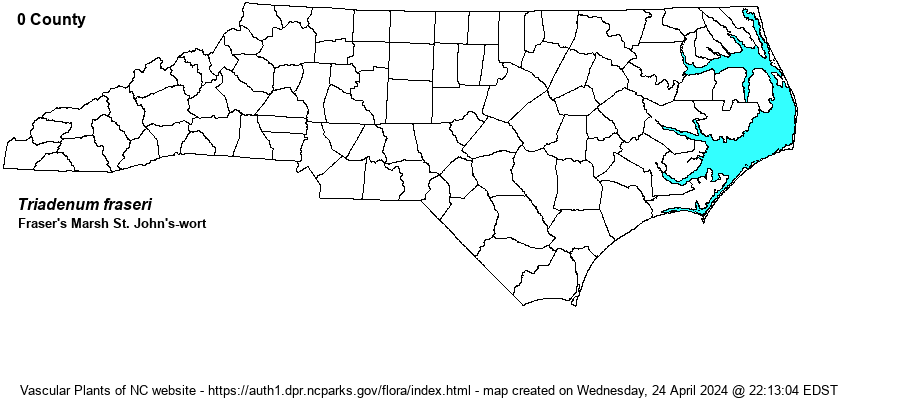| Author | (Spach) Gleason | |
| Distribution | Of uncertain occurrence in the state, and probably not present. Reported in a vegetation plot in Northampton County; however, reports from vegetation surveys should be used with caution, as there may not be a specimen, identification may have been deduced from a young or vegetative individual, and/or identification may have been made many days after the observation. Weakley (2022) mentions that it occurs south to “w. NC (?)”, and with a "?" in the Mountains. The BONAP map shows it occurring south in VA to the NC border in the Mountains, and a record for the Delmarva Peninsula. The SERNEC collections database has no specimen records for the state.
This is a Northern species occurring across Canada and then south to PA, sparingly to eastern and western VA, northeastern TN, and IL. Thus, occurrence in northeastern NC is not likely; this is a very difficult species to separate from T. virginicum, with which it has been included in the past.
| |
| Abundance | Extremely rare, and probably not present at all. The NCNHP considers this as a Significantly Rare species with a State Rank of S1?. However, this website follows Weakley (2022) and other references/websites and believes the species never to have been adequately documented in the state and gives the rank as SR (Reported only), with no suggested State Status. | |
| Habitat | Unknown in NC. The Digital Atlas of the Virginia Flora says “Bogs, mafic fens, seeps, seepage swamps, depression ponds and swamp; usually in peaty, nutrient-poor soils.” | |
| Phenology | Blooms in July and August, and fruits shortly thereafter. | |
| Identification | This is a deciduous herbaceous species that is rhizomatous and thus occurs in colonies; it reaches about 1 foot tall. It has opposite, widely elliptic and entire leaves that are rounded at the tip and notably clasping at the base; they average about 1.5 inches long. The flowers are rather small and pink, about 2/3-inch across, and grow mainly in the leaf axils but also at the end of branches. Triadenum virginicum is essentially the same, except that T. fraseri has sepals that are 2.5-5 mm long, as opposed to 5-8 mm in T. virginicum; also, the latter is essentially restricted to the Coastal Plain in NC. The Triadenum species – fraseri, tubulosum, virginicum, and walteri – all have pink flowers and mostly have reddish, pink, or flesh-colored stems that are rather noticeable. | |
| Taxonomic Comments | Many references consider this species as a variety of T. virginicum.
| |
| Other Common Name(s) | None. It is unfortunate that the four “Triadenum” species are stuck with an extra-long common name, adding “Marsh” before “St. John’s-wort” for the entire group – Marsh St. John’s-wort -- and thus each of the four species must have a modifier word, a fifth word in the name, to distinguish each other. | |
| State Rank | S1? [SR] | |
| Global Rank | G5 | |
| State Status | SR-P [--] | |
| US Status | | |
| USACE-agcp | | |
| USACE-emp | | |

